|
| |
Back to Private
Aircraft
|
|
The Aerospatiale Rallye started life as the
Morane-Saulnier MS880, a simple two seat tourer and trainer. It
first flew in June 1959. Morane-Saulnier was taken over by Sud
Aviation, who set up a general aviation subsidiary called SOCATA (Societe
de Construction d'Avions de Tourisme at d'Affaires). Sud Aviation
was later absorbed into Aerospatiale, who retained the Socata brand
for its range of light aircraft. Over
3,600 of the Rallye series have been built, making it probably the
most successful post-war European civil aircraft. It has achieved
this position by offering a wide range of variants at competitive
prices: these include the two seat Rallye Club and the more powerful
four seat Rallye Minerva and Rallye Commodore. At the time of
writing (January 2006), the type is still in very low rate
production by PZL in Poland as the Koliber.
One characteristic of the Rallye is its
excellent low speed handling, achieved by the use of large flaps and
full span slats, unusual for a light aircraft. Unfortunately these
also make it complex and expensive to maintain. The several variants
have a wide range of possible engines, from 100 to 235 hp, from
Continental, Lycoming or Potez. Gross weight ranges from 1,700lb (Ralye
Club) to 2,350lb (Rallye 235), and top speed from 110 to 165mph.
Range is typically 500 miles. It is 22 feet 11 inches long, with a
wing span of 31 feet 6 inches.
The top picture shows a Rallye STOL at Toussus-le
Noble in May 1983. The middle picture shows a half dismantled Rallye
at Skegness in Summer 2005. The lower picture shows a Rallye
Agricole at Farnborough in September 1980. |
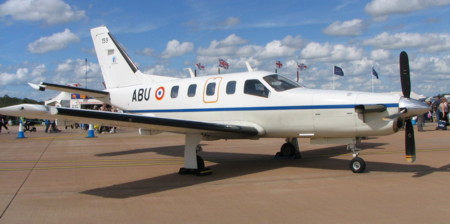 |
Aerospatiale (SOCATA) TBM-700
Fairford, July 2007 |
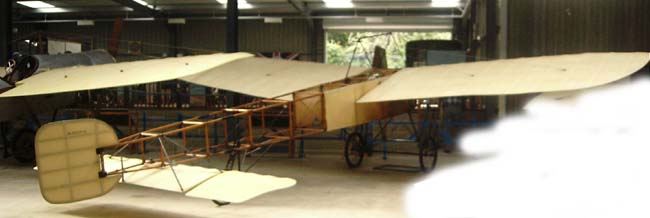 |
Louis Bleriot achieved immortal fame in his Bleriot XI
when he became the first man to fly across the English channel. The
aeroplane first flew in May 1909, and Bleriot made his Channel
crossing in it on 25 July. Powered by a 25hp Anzani engine, the
aircraft is a single seater, 22 feet 11 inches long, with a wing
span of 25 feet 5 inches. Gross weight is 700lb and top speed of
only 45 mph. The success of the flight assured the popularity of the
type; it was progressively developed, including a two seat trainer
used by the French air force into the First World War.
Many are preserved in museums, including this original example, photographed by Ivy
at Old Warden in April 2005. |
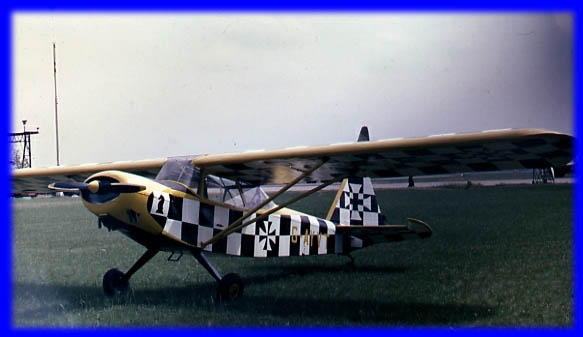 |
The Brochet MB84 is a stylish two seat
touring aircraft designed in the early 1950s by Maurice Brochet. The
MB80 series was built in very limited numbers, only about ten being
completed. This one is the only
example to be imported to the UK, where it was pictured at
Sunderland in the mid 1970s. It is powered by a 65hp Continental
engine Gross weight is 1,200lb. It cruises at 95mph and has a range
of 310 miles. Wing span is 34 feet 3 inches and length 21 feet 7
inches. |
|
|
The CAP series of competition aerobatic
aircraft derive ultimately from Claude Piel's Emeraude of the 1950s.
The CAP10 is essentially an Emeraude, modified by Avions Mundry with
a 180hp engine and stressed for aerobatics. The CAP20 is a single
seat version of the CAP10. The CAP21 introduced a new wing of
symmetrical section. Progressive improvements by Mundry, then
Akrotech, from then on resulted in the ultimate (so far) CAP, the
232. This has a 300hp Lycoming AEIO-540 engine, giving it a top
speed of 200mph. Gross weight is 1,800lb. It is 22 feet 2 inches
long, with a wing span of 26 feet 6 inches. Most importantly, it has
outstanding handling, and is capable of the most complex aerobatic
manoeuvres. Of the single seater CAPs, 40 CAP 20 & CAP21s were
built, plus around 30 of the CAP 231. The CAP232 is still in
production (by Akrotech, now renamed CAP Aviation).
Top: CAP10 at Headcorn, June 2006. Bottom: CAP232 at Old Warden in April 2005. |
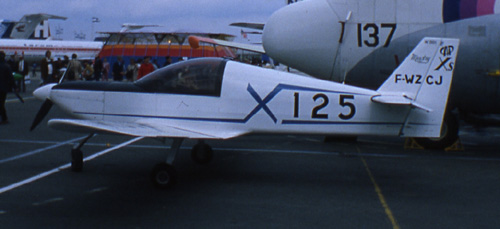 |
The CAP-XS was an abortive attempt by Avions
Mundry to produce a low cost two seat trainer. It was powered by a
115hp Lycoming engine, which gave it a cruising speed of 130mph and
range of about 350 miles. It was 19 feet 4 inches long, and 26 feet
3 inches long, with a light weight of 1,170lb. As far as I know,
only two were made before the project was abandoned.
This is the first prototype, which was at Le Bourget in
May 1983 |
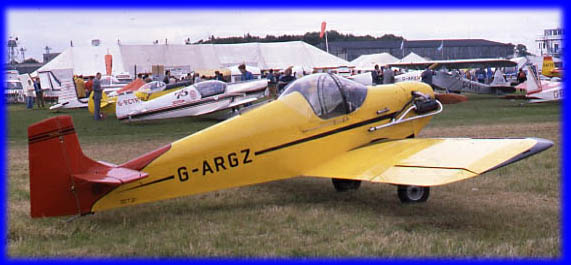 |
The Druine D31 Turbulent was designed by
Roger Druine in 1950. It is a diminutive machine, a single seater,
designed to be powered by a variety of engines: most popular are
converted Volkswagen engines of 30hp or so. Maximum weight is 620lb;
length 17 feet 4 inches; wing span 21 feet. Top speed is just over
90mph. It is often used for `barnstorming' displays such as flour
bombing, precision flying through obstacles, and the like. Apart
from numerous homebuilt examples, 29 were built by Rollason Aircraft
& Engines at Croydon in the UK. This one
is a Rollason built example, pictured at Leicester in July 1980. |
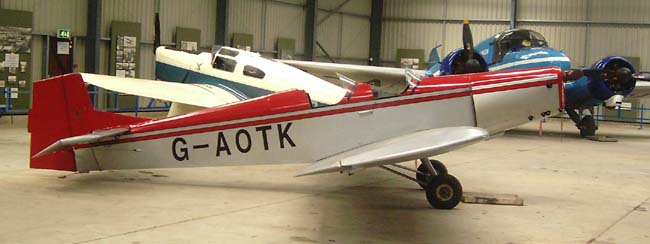 |
The Druine D52 Turbi is a two seater designed
by Roger Druine using similar principles to the Turbulent. It is
necessarily bigger and heavier, needing engines of around 60hp (this
one has a Walter Micron). Maximum weight is 1,100lb; length, 20 feet
4 inches and wing span 28 feet 6 inches. Top speed is 100mph. Very
few were built.
This one was at Old Warden in April 2005. Photograph by Ivy |
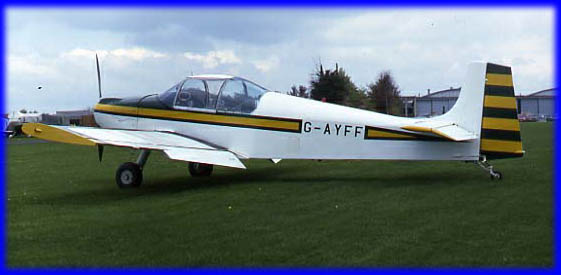 |
The Druine D62 Condor was designed by Roger
Druine as a side by side two seater. Some 50 were built at Croydon
by Rollason Aircraft & Engines from 1961 to 1972. Powered by a 100hp
Rolls-Royce Continental engine, it is a popular aircraft, with very
pleasant handling characteristics. It is 22 feet 10 inches long,
with a wing span of 27 feet 6 inches, gross weight of 1,475lb. It
can cruise at 100mph for up to 385 miles.
This one was at Old Sarum in May 1987. |
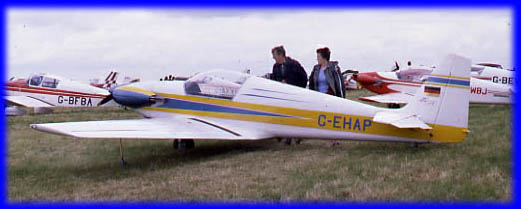 |
The Fournier RF4 is a deceptive aircraft: it
looks at first sight like a powered glider, but it was in fact
designed from the first as a powered aeroplane but with good gliding
characteristics. Apart from being a very sleek design, it is
economical to fly: on a 1600cc VW engine, it manages to cruise at
110mph. It is a single seater, 19 feet long but with a wing span of
37 feet. Many were built in France by Alpavia, and even more in
Germany by Sportavia (the former Putzer company).
This one was at Leicester in July 1980. |
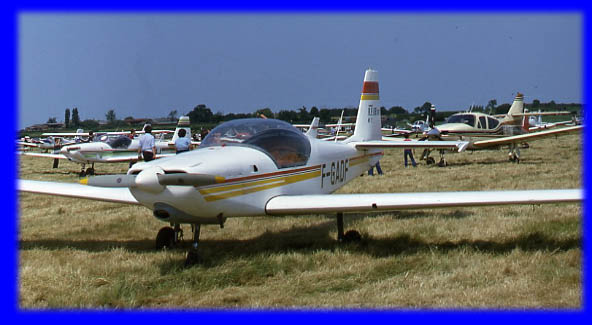 |
The Fournier RF6B is a two seat, wooden
trainer designed with typical refined elegance by Rene Fournier. It
first flew in March 1974. Its 100hp Continental O-200 engine gives a
top speed of 125mph, range of 400 miles and gross weight of 1,650lb.
It is 22 feet 9 inches long with a wing span of 34 feet 1 inch.
After 46 had been built, the design was sold to Slingsby in the UK,
who modified it for glass-fibre construction and continue to market
it as the Slingsby Firefly. This RF6B
was at Cranfield in July 1983. |
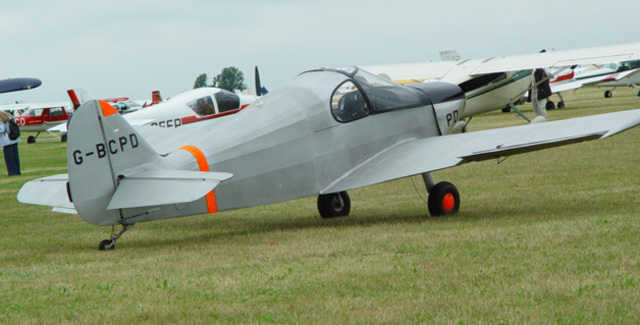 |
The Gardan GY20 Minicab was designed by Yves
Gardan and first flew in 1949. It is a simple wood and fabric two
seater, powered by a 90hp Continental engine. This gives it a
cruising speed of 110mph and range of 450 miles. It is only 17 feet
long, with a wing span of 25 feet. Despite its attractive lines it
has never been very popular, mainly because it was competing in the
space more successfully occupied by the Jodel series. A substantial
proportion of the 50 to 60 Minicabs to have flown have been
homebuilts.
This one was at Kemble in July 2005. |
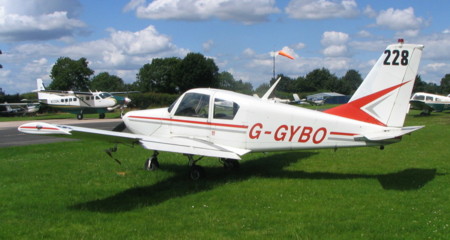 |
The Gardan GY80 Horizon is a stylish four
seat touring aircraft with retractable undercarriage, which first
flew in July 1960. 273 of them were produced by Sud Aviation.
It is powered by a 150hp Lycoming O-230 engine, which gives it a
cruising speed of 150mph and range of 750 miles. It is 21 feet 9
inches long, with a wing span of 31 feet 10 inches.
This one was at Wellesbourne Mountford in July
2007. |





|